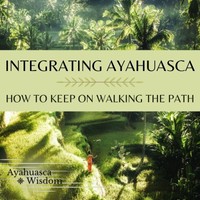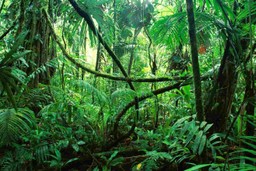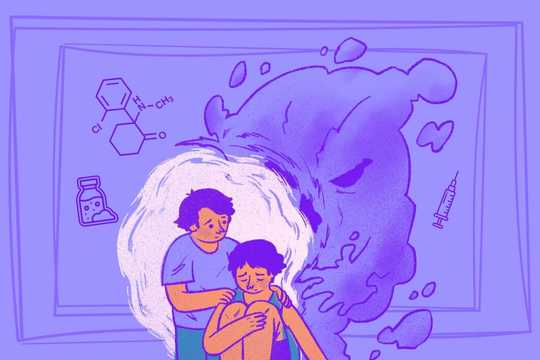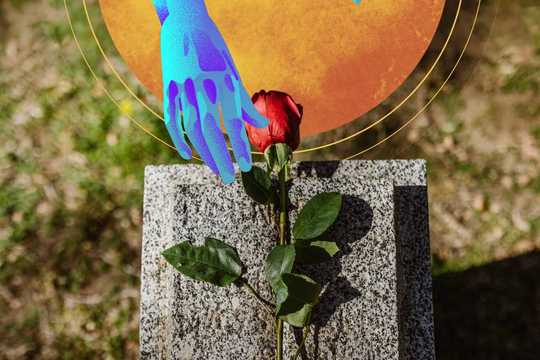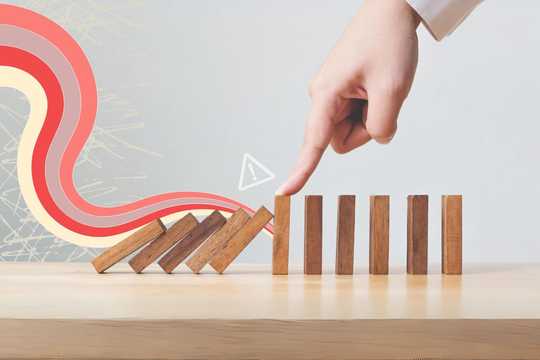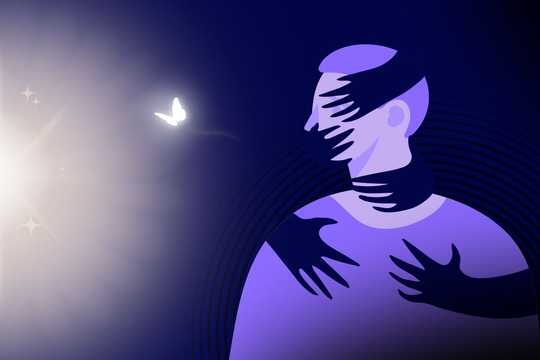Hallucinogenic therapy article originally featured on Kahpi.
Ryan was a meditator, experienced with ayahuasca, so it surprised him (not in a good way) when a disturbing ceremony revealed the world as hollow and grotesquely meaningless. In the aftermath, he felt dissociated and numb. It took him the better part of a year to recover. Afterwards, he was still wondering what had happened when we met several years later. He’d been wary of ayahuasca ever since.
Ayahuasca can be powerfully therapeutic. More and more scientific research is showing how ayahuasca can help people overcome severe depression, addiction, chronic grief and loss, and other problems. The research parallels the abundance of stories on the internet. Stories discuss people gaining different types of healing from their work with the brew. I‘ve met many individuals who are deeply grateful for how ayahuasca has helped change them. Some even claim, sincerely, that it saved their life.
Yet, there is a thorny issue at the heart of the ayahuasca path that people often avoid talking about. Some people actually feel not better but worse after drinking the brew. What should we make of this fact? First, let’s consider some more examples.
Hallucinogenic Therapy Can Rough You Up
Anna came knocking on my door the morning after an ayahuasca ceremony, still terrified. The experience had been overwhelming. Thus, triggering the feeling that “ayahuasca hates me.” She could connect this with feelings she had as a little girl, being afraid of her mother. But she was nowhere near resourced enough to assimilate this insight.
Francesca did 16 ceremonies in 21 days. This wasn’t the first retreat she’d attended in Iquitos, Peru. In the last ceremony, she found herself lost in a vortex of zombie-like figures. It seemed to last for hours. Then, when I saw her a week later, she was having near-constant anxiety interspersed with panic attacks. Worse yet, she had barely slept since then.
I could offer many vignettes of beautifully transformative ayahuasca experiences. But here I’m acknowledging a truth I encounter frequently as an integration therapist, as well in my own personal work. Sometimes the ayahuasca experience appears to be traumatizing in itself. Is hallucinogenic therapy worth the trouble?
What Is Trauma, Anyway?
Trauma can happen with any overwhelming circumstance. A basic hallmark of a traumatic experience is anything that’s “too much, too fast, too soon” for a particular human nervous system to handle. A major determinant in whether an experience generates lasting trauma is how innately resourced a person is. This has a great deal to do with the degree of secure attachment and support he or she received in infancy and childhood. People who lacked secure attachment are more likely to develop post-traumatic stress disorder (PTSD) in circumstances that might disturb a securely attached person but not create a chronic disorder.
So let’s bring in ayahuasca and hallucinogenic therapy. The plant medicine generates extremely strong, and sometimes fragmenting, experiences. And let’s not beat around the bush. Ayahuasca can be incredibly scary. A hundred-odd ceremonies in, I still feel apprehension every time I drink. Furthermore, I can still slide into fear when the level of intensity ratchets up. I’ve had my own experiences with something I am only semi-facetiously calling post-ceremony stress disorder or PCSD.
Chaos on Display During Hallucinogenic Therapy
I’ve also witnessed some of the extreme reactions that can manifest in ayahuasca retreats in Peru when a pasajero (international visitor) has a terrifying experience in ceremony, and the chaotic, disorganized energies inside their nervous system emerge in full display. It seems to me that people tend to respond to these overwhelming experiences with whatever is their default method of control. They may go into flight, as in actually leaving the ceremony (not a good idea), or quitting mid-retreat. Or fight, which can manifest as a full-on rage attack (pity the facilitator who bears the brunt of it) or, milder, as a monologue of blame: “These ceremonies are not done right; this shaman is no good; this center is not safe; the guy sitting next to me is a jerk.”
Some mindsets spin into obsession, panicky thinking that whirls in circles and goes nowhere. Other people dissociate and withdraw, going mute and numb. Sometimes people simply collapse, blacking out—hopefully onto a mattress, but it doesn’t always happen that way.
Such experiences are not the end point of work with ayahuasca. Often they’re particularly intense pit-stops on the way to more complete healing. Still, they’re highly uncomfortable and not uncommon. We may write them off as a bad ceremony. However, I wonder if there’s more to the picture.
“No Such Thing as a Bad Trip”
Dr. Gabor Maté said some intriguing things at a Psychedelic Science 2017 workshop on ayahuasca. “There’s no such thing as a bad trip on ayahuasca,” Maté believes. “People say, ‘I felt fear, terror, rage, confusion such as I never felt before.’ ‘Yes, you have,’ I say. ‘You just don’t recall it.’”
He suggested that what we call a “bad trip” could be a reactivation of early childhood trauma. These can be overwhelming experiences, infant or even prenatal. They are encoded not in the brain’s centers of cognitive memory (these don’t develop fully until 18–24 months of age) but directly into the body.
When these feelings erupt within an ayahuasca session, they can manifest as overwhelming sensations and emotions that seem unrelated to any known circumstance. Arising in disconnected, incoherent form, they’re unaccompanied by any sense of meaning. The chaotic nature of certain difficult ayahuasca experiences can lead to overwhelming sensations, incomprehensible surges of powerful emotions like terror, grief, or despair. Correspondingly these emotions parallel the overwhelming feelings a small child might experience in trauma.
Infant Neurology
To really understand how this can happen, it helps to look a little more deeply at infant neurology. A baby or small child can often bear an overwhelming experience, if there’s some kind of holding environment. The sustained presence of a loving, attuned adult who can empathize with the child’s experience and serve as a bigger nervous system for the energies to pass through works best. From attunement with this kind of presence, infants learn that they can endure difficult emotions, and that these will eventually pass. This is the cultivation of resilience. Knowing you can move through distress and ultimately be okay.
Many children don’t have this secure holding environment or receive only a partial version of it. In these cases, the child resorts to more primal survival mechanisms. These mechanisms are often a kind of shutoff or dissociation that stuffs away the overwhelming experience in the body and brain, so that it’s present, yet unconscious. It’s repressed because it’s literally unbearable. The child’s nervous system is simply not developed enough to survive the experience in full consciousness.
Self and Experience Splits
This split between self and overwhelming experience forms the template for the imprint of trauma. It forms the separation from Self/Other/God/Nature that so many of us struggle with. Often we don’t even know this is the effect of trauma, and the feeling of immense shame at our inadequacies. Disconnection is the essence of trauma. Ayahuasca, as an intrinsically connective agent, has the potential to heal. (I write more about this here: 6 Ways Ayahuasca Works Like a Good Trauma Therapist).
Sometimes the path to healing means experiencing the buried emotions and sensations we would have felt in those unbearable experiences, had we been able to meet them fully. Ayahuasca seems to be a consummate expert at evoking these feelings. In my personal work, I now see how certain chaotic ayahuasca sessions I originally attributed to a too-strong dose of the brew could be the release/processing of overwhelming traumatic experiences that I endured when young. It’s a grim ride to journey through the complete fragmentation of your psyche, this time in full adult consciousness.
Why Integration Support Is Crucial
Ayahuasca and hallucinogenic therapy is superb at opening up past trauma. However, it doesn’t always resolve it in the space of a single night, or even a single retreat. Thus, this is where the need for trauma-specific integration support comes in. As an integration therapist, I find such support to be crucial in helping to calm the body and stabilize the nervous system. As a result, this opens the system up so that one can integrate
Real, trained, human support allows you to make your way through difficult terrain with a modicum of grace and ease. Without it, difficulties can last long past the ceremony. Old issues you thought you’d worked through can flare up again. This can trigger depression, anxiety, fear, and sleeplessness. In other words, it can be a rough ride.
Follow your Curiosity
Sign up to receive our free psychedelic courses, 45 page eBook, and special offers delivered to your inbox.Me, I’ve had some hellish post-ceremony experiences that took weeks to resolve. Despite all my training and awareness—I’m a trauma therapist myself!—I couldn’t provide my own support. I needed skilled human contact from a different nervous system than mine, and it wasn’t available. This baptism by fire helped me understand firsthand the raw and terrifying instability of traumatic states opened up by ayahuasca. Above all, I learned what it takes to come through them.
“Normal” Can Be Rough After Hallucinogenic Therapy
I often see how post-ceremony, people often head directly back into their “normal,” insufficiently supported environment, expected and expecting to function full-throttle immediately, when the reality is they’ve just undergone major psychic surgery and need some quiet integrative time and support to obtain the maximum benefit from the work they’ve just done.
This is why I’m always telling people: take the day after a ceremony completely off. Don’t plan travel for immediately after a retreat or hallucinogenic therapy. Assemble your resources beforehand. And reach out for integration support as necessary. Sure, you’ll survive on your own and get through, regardless—but the grace and ease that good support can bring goes beyond simple comfort. It can actually help to repattern the traumatized nervous system from its survival-oriented, fight/flight/freeze reflexes into a more open and relaxed state of social engagement. Every time we experience this kind of shift, it contributes to a more permanent and stable system-wide upgrade.
What Works
In working with people seeking to deal with the aftermath of PCSD, I’ve found even a single session can be of great value. If the experience is still fresh, we might use Somatic Experiencing techniques to calm and stabilize the nervous system. This kind of work also opens up the pathways for integration: you simply can’t integrate when your system is frozen in panic.
If someone is bringing an older ayahuasca experience that’s less fresh but still painful, we might explore the meaning of what possibly happened on that night. “Meaning makes all things bearable,” Carl Jung says, and this certainly applies to work with plant medicine. Sometimes this involves checking in again with the original intentions, which can be fulfilled in paradoxical if not literal ways. It can be comforting to realize that you actually did get what you asked for—even if it wasn’t what you were expecting.
I know a woman who endured a horrible ceremony in which for some 12 hours she felt like she was being utterly torn apart. Then she went home and her life spontaneously and completely changed, for the better. “Why did ayahuasca do that to me?” she was asking several years later. It took some work for us to connect the dots, to open to the possibility that maybe the miraculous shift in her life had something to do with the intensely difficult ceremony she experienced. Or maybe not. We never really know. We just create the stories that work for us, as is our prerogative as meaning-making creatures.
Ways to Work With PCSD
So, going back to the beginning of this story, with Ryan (and by the way, all these names are changed), I mentioned to him the devastating loop of meaninglessness some people fall into when smoking the powerful psychedelic DMT. It was strangely comforting for him to understand that his experience might not be an entirely personal phenomenon. Hearing that this can happen with DMT lessened his fear of going insane.
Anna simply needed to rest, eat, and sleep before she came back for another session. By that time she was in better shape to look at her relation with her mother, and how ayahuasca, the biggest mama of all, might have triggered the childhood trauma she experienced in being terrified of the person who was supposed to protect her.
And with Francesca, some practices drawn from Somatic Experiencing helped her sleep that night, for the first time in a week. Within a few days she was well on the path to integration.
Hallucinogenic Therapy isn’t Always Easy
The fact is that ayahuasca can be traumatizing for a particular individual, even a well-prepared one—although more often than not, the difficulties occur with someone who’s unprepared, actively misusing drugs, or has a personal or family history of mental illness. Researcher Jessica Nielson says that people with a self-reported past or current diagnosis of PTSD are somewhat more likely to report ayahuasca being a traumatizing experience in itself.
This doesn’t mean don’t do it. It does mean be somewhat prepared for the possibility with hallucinogenic therapy. Especially if you have a history of PTSD, have some support lined up, and reach out in the aftermath as necessary to get more. I believe ayahuasca has tremendous potential to heal PTSD, but it’s not a simple matter of drinking it and waiting to be cured. Active integration is part of the work, too—and it can help immensely if integration support is trauma-specific.


